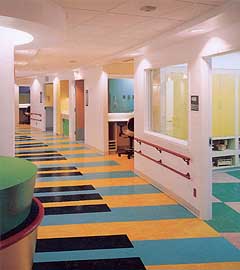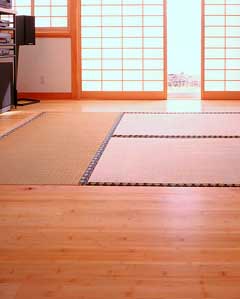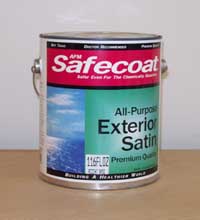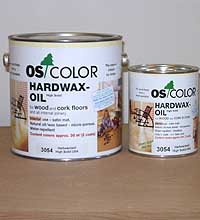|
Subscribe / Renew |
|
|
Contact Us |
|
| ► Subscribe to our Free Weekly Newsletter | |
| home | Welcome, sign in or click here to subscribe. | login |
News
| |
 |
June 28, 2001
Green building begins with rethinking old habits
Journal Staff Reporter

Forbo linoleum tiles
Manufacturer: Forbo Linoleum, Inc. What it is: Linoleum floor files What makes it green: Linoleum is an all-natural product made of linseed oil, pigments, pine rosin and pine flour. “In a garden it would decompose,” Schulman says. Why it’s recommended: Though linoleum has long been out of fashion, it’s very durable, water resistant and easy to clean. “It just fell out of favor with the marketing of the shinier vinyls that we all expect our flooring to be,” Shulman says. Forbo’s line of tiles comes in 31 colors and 13 coordinated borders. |

TimberGrass bamboo flooring
Manufacturer: TimberGrass, LLC What it is: Bamboo hardwood flooring What makes it green: “Bamboo in general is a renewable product,” Shulman says. Hardwood trees require over 40 years to grow to maturity, but bamboo can be harvested in just six years. TimberGrass’s bamboo supply is grown on plantations, and the species is not a food source for pandas. Why it’s recommended: Environmental Home Center has used a number of different bamboo suppliers, but Bainbridge Island-based TimberGrass has provided the best, most consistent product, Shulman says. According to company literature, the product expands and contracts less than any commonly used wood flooring, and passes construction standards for a variety of strength and durability requirements. |
Green building isn’t going to be revolutionized by any hot, new product.
“Most of the tools that we need to be building green are here right now,” says David Shulman, the sales director at the Environmental Home Center in Seattle’s Sodo area. To that end, the store and its companion Web site sell environmentally sensitive products that are generally free of toxins and nonrenewable resources.
Nevertheless, the key ingredient for creating a sustainable future, says Shulman, is for people to rethink their consumption habits. “People are creatures of habit, and so there’s a great capacity in the human spirit to deny. ... People are not comprehending the enormity of the impact of the construction industry.”
The suppliers of green-building products and services must therefore also serve as educators, marketers and sales people to raise awareness of issues that most fail to consider, such as the harmful effect of paint chemicals on indoor air quality.
Still, it’s tough to change people’s buying habits, and “that’s why so many businesses like ours across the country have failed,” Shulman says. “I have contractors who will literally not use our paint because they’ve never used it before. It’s still paint, but it simply has things missing that might kill you.”
Shulman thinks green-building products will eventually be handled by mainstream vendors, just as organic food is now. If consumer interest continues to grow, the mainstream marketplace will awaken to the opportunities.
Yet many consumers who are interested in buying green products have no idea where to begin. Shulman has several suggestions for products that can be incorporated into ordinary projects.

|
Safecoat paints
Manufacturer: AFM What it is: Environmentally safe paints What makes it green: The paints contain neither volatile organic compounds nor toxins such as formaldehyde, ammonia, acetone or odor-masking agents. Because of their potential toxicity, they also do not contain mildew- or fungus-killing properties. Why it’s recommended: “This product was initiated with only one mission in mind: to make a paint for the chemically sensitive,” Shulman says. “They eliminated all the toxins they can.” Consequently, there is almost no odor during application. Minuses: “It’s expensive,” Shulman says. “It is price-competitive with premier paint. There is a price barrier to overcome.” Shulman says there has been little press calling attention to indoor air-quality issues, and that it will take better marketing to raise demand for the product. |

|
OS Hardwax Oil
Manufacturer: Ostermann & Scheiwe GmbH (Germany) What it is: An oil floor finish What makes it green: Unlike common plastic floor finishes such as polyurethane, OS Hardwax Oil is mostly made up of natural, renewable ingredients such as vegetable oils and waxes. It contains no preservatives or toxins. Why it’s recommended: Most oil and wax finishes have been known to have durability problems, but OS Hardwax Oil appears to carry no such baggage. Even better, says Shulman, the finish is repairable, unlike other finishes that are in common use. Though more expensive per unit, hardwax oil is applied in fewer coats than polyurethane, and simpler maintenance makes the hardwax oil less expensive to use in the long run. |
 |
Expanko cork flooring
Manufacturer: Expanko Cork Co., Inc. What it is: Traditional cork tile, bare and pre-finished What makes it green: Cork is a renewable resource made from the bark of the cork oak tree. Once the bark is harvested, trees are given nine years to recover. Cork production also helps to preserve forests. Why it’s recommended: “Cork is durable, warm and soft to the touch,” Shulman says. “It’s an insulating product, for sound as well as temperature.” Environmental Home Center carries more than one line of cork flooring, but Shulman singles out Expanko’s tiles for being attractive and well-made. |
For more information about these products, call the Environmental Home Center at (800) 281-9785 or see its Web site at www.built-e.com. The store address is 1724 Fourth Ave. S. in Seattle.
Jon Silver can be reached at (206) 219-6529 or by e-mail at jsilver@djc.com.
Jon Silver can be reached by email or by phone at (206) 622-8272.
Other Stories:
- Can you build green without going in the red?
- Built for life
- Affordable AND green?
- Partnerships enhance green development
- Web site aids sustainable building design


